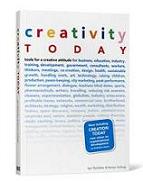I’m not creative
“I’m not creative.” How often have I said this to myself?
“I’m not creative.” Have you ever said that to yourself?
“You’re not creative.” Has someone ever said that to you?
“I’m not creative.”. Can you feel your brain cells going to sleep, as you read it? Can you feel your mind getting numb? Sorry about that. Convincing yourself you’re not creative is the worst idea killer. There are many more.
Why don’t you go out and do something creative?
Years ago I saw an interview on TV of some guy whose hobby was computer programming. He talked enthusiastically about a computer game he was writing.
At the end, the interviewer asked “That sure takes up a lot of your time. Why don’t you go out and do something creative instead?”
A long silence ensued, while the programmer tried to find something that would fit the (probably very narrow) definition of creativity the interviewer used.
So, what is your definition of creativity?
Creativity Today
Creativity Today explains the creative process. A process to be creative? Yup. If you want to get results, a good structure is required. I like structure. Creativity Today uses a simple structure with four phases and gives techniques for each phase. The process has many similarities with the Retrospective process. Both processes have the same goal: action plans for innovative improvements. Some tools are used in both processes. In both cases, you need good coaches who can keep the environment safe, avoid ‘idea and innovation killers‘ and keep the focus on forward movement and results.
There are enough techniques and tools to create variation and keep the process ‘fresh’. Each technique is clearly described and analyzed, so that you can select the right tool for the right task. Several techniques are useful in learning settings like training or conference sessions. Come and experience them at one of the many fine agile events around the world.
The book contains plenty of coaching tips, examples and exercises. The layout and structure is (as you might expect) playful and original, but every element is clearly recognizable. This is very useful if you need to look something up.
At the end of the book, there’s a short extra section about organisational creativity. This section contains mostly case studies, less about techniques or approach. After the simple, engaging tone of the main part of the book, the ‘woolly’ language of this section made it hard for me to get the message. To make this part better I would either restrict it to the case studies, which show the techniques at work OR expand this section and provide a process and technique to scale the techniques up from the team to the organisation. And use simpler language.
And? Does it work?
Scintillating Stien and I have just finished a creativity workshop for a customer. We used the process from Creativity Today, with several techniques from the book. We added a few techniques and additions of our own, to make the workshop fit the needs of the task and the customer. The improv’ theater techniques from “En… Actie!“, funny video clips and some music added a good atmosphere and energy between the different segments.
We still need to do the full evaluation, but the first reactions were very positive. We got the results we wanted in the expected time. We tackled some hard problems and had fun doing it. This team now has everything they need, to create what they want to make. You’ll hear more from that team!
Creativity is a skill
Creativity is not something you are ‘born with’. Or rather, we are all born with creative skills, but we have to learn and train to master the skill. We must resist the forces that make us ‘unlearn’ the skills. I have trained, created and learned with the Bold Bootcampers, the Kid Ketjes, Ceaseless Cyriel, Shiny Stien (when can we expect the blog?), Vivacious Vera, Rollicking Rob, Perceptive Portia and all the people I have worked and played with these last years.
Creativity is a team sport.
I’m creative.
You are creative
Go out and do something creative. Today. You know you can.

[…] learning, usefulness of materials and the amount of fun had by all. The techniques covered included Creative Thinking process, Edward de Bono’s 6 Thinking Hats, Chris Avery’s Responsibility Model and Burndown […]
[…] to value my logical brain over my creativity side. Experience has taught me that tapping into my creativity creates opportunities I never thought possible. One life. Live it well. The only real currency we have is time. Invest […]